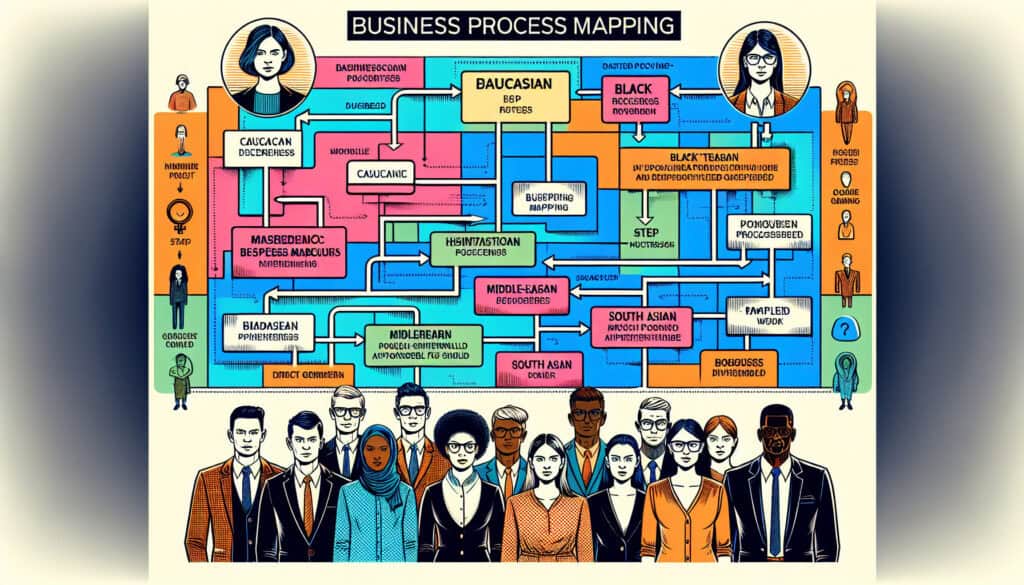The activity of creating a detailed flowchart or map of a work process, showing the sequence of tasks and the people or groups responsible for each step.
- Methodologien: Kunden & Marketing, Wirtschaft, Lean Sigma, Herstellung, Projektmanagement, Qualität
Business Process Mapping

Business Process Mapping
- Geschäftsprozess-Reengineering (BPR), Kontinuierliche Verbesserung, Schlanke Fertigung, Prozessverbesserung, Prozessabbildung, Prozess-Optimierung, Qualitätssicherung, Qualitätsmanagement, Wertstrom-Mapping
Zielsetzung:
Wie es verwendet wird:
- It is used to visualize a process to better understand it, identify inefficiencies, and communicate it to stakeholders. Maps can range from simple flowcharts to more complex diagrams.
Vorteile
- Provides a clear visual representation of a process, helps to identify bottlenecks and areas for improvement, and facilitates communication and training.
Nachteile
- Can be time-consuming to create and maintain, may become overly complex and difficult to understand, and the map is only as accurate as the information used to create it.
Kategorien:
- Herstellung, Problemlösung, Projektmanagement, Qualität
Am besten geeignet für:
- Visualizing and analyzing a workflow to identify inefficiencies and opportunities for improvement.
Business Process Mapping plays a significant role in various sectors including manufacturing, healthcare, finance, and software development, as it provides a structured approach to visualizing workflows within these industries. In the context of project management, this methodology is particularly effective during the initial phases of process analysis and design, helping teams clarify current processes before implementing new systems or technologies. Participants usually include process owners, project managers, analysts, and often end-users, ensuring comprehensive input that captures all aspects of the workflow. For example, in healthcare, mapping medication administration processes can reveal bottlenecks that lead to medication errors, enabling improvements in patient safety. In software development, visual maps can illustrate user journey flows, ensuring that the design aligns with user expectations and needs. Tools such as BPMN (Business Process Model and Notation) offer standardized symbols to create diagrams that communicate effectively across departments, bridging gaps between technical and non-technical stakeholders. This approach enhances training by providing a visual reference that learners can refer to, making the understanding of complex procedures more accessible. Additionally, mapping enables a comparative analysis of alternative processes, supporting businesses in making data-driven decisions regarding potential improvements or automation strategies, which can lead to significant cost savings and productivity gains over time.
Die wichtigsten Schritte dieser Methodik
- Define the process scope and the boundaries clearly.
- Identify process inputs, outputs, and key stakeholders.
- Map the current state of the process using flowcharting techniques.
- Identify and analyze bottlenecks and inefficiencies within the current process.
- Propose improvements and alternative workflows based on the analysis.
- Create a future state process map reflecting the proposed changes.
- Validate the future state map with stakeholders for alignment and buy-in.
- Develop an implementation plan for the proposed changes.
Profi-Tipps
- Engage stakeholders early in the mapping process to ensure their perspectives and knowledge are incorporated, building collective ownership and increasing buy-in for future improvements.
- Use simulation tools in conjunction with business process mapping to model various scenarios, allowing for predictive analysis of changes before implementation.
- Regularly update and review process maps to reflect changes in workflows or organizational objectives, maintaining relevance and effectiveness in continuous improvement efforts.
Verschiedene Methoden lesen und vergleichen, Wir empfehlen die
> Umfassendes Methoden-Repository <
zusammen mit den über 400 anderen Methoden.
Ihre Kommentare zu dieser Methodik oder zusätzliche Informationen sind willkommen auf der Kommentarbereich unten ↓ , sowie alle ingenieursbezogenen Ideen oder Links.
Historischer Kontext
1949
1950
1950
1960
1960
1960
1960
1940
1950
1950
1958
1960
1960
1960
1960
(wenn das Datum nicht bekannt oder nicht relevant ist, z. B. "Strömungsmechanik", wird eine gerundete Schätzung des bemerkenswerten Erscheinens angegeben)















Verwandte Artikel
Fragebögen zu muskuloskelettalen Beschwerden
Multivariate Tests (MVT)
Mehrfache Regressionsanalyse
Motion-Capture-Systeme
MoSCoW-Methode
Moods Median-Test